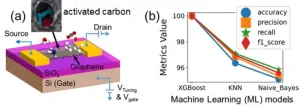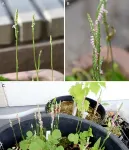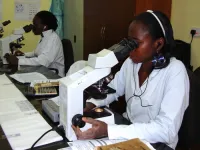New machine-learning approach enables to identify one molecule in a billion molecules selectively with graphene sensors
2023-03-17
(Press-News.org)
Graphene’s 2D nature, single molecule sensitivity, low noise, and high carrier concentration have generated a lot of interest in its application in gas sensors. However, due to its inherent non-selectivity, and huge p-doping in atmospheric air, its applications in gas sensing are often limited to controlled environments such as nitrogen, dry air, or synthetic humid air. While humidity conditions in synthetic air could be used to achieve controlled hole doping of the graphene channel, this does not adequately mirror the situation in atmospheric air. Moreover, atmospheric air contains several gases with concentrations similar to or larger than the analytic gas. Such shortcomings of graphene-based sensors hinder selective gas detection and molecular species identification in atmospheric air, which is required for applications in environmental monitoring, and non-invasive medical diagnosis of ailments.
The research team led by Dr. Manoharan Muruganathan (formerly Senior Lecturer), and Professor Hiroshi Mizuta at the Japan Advanced Institute of Science and Technology (JAIST) employed the machine learning (ML) models trained on various gas adsorption-induced doping and scattering signals to realize both highly sensitive and selective gas sensing with a single device.
The ML models' performances are often dependent on the input features. ‘The conventional graphene-based ML models are limited in their input features’, says Dr. Osazuwa Gabriel Agbonlahor (formerly post-doctoral research fellow). The existing ML models only monitor the gas adsorption-induced changes in the graphene transfer characteristics or resistance/conductivity without modulating these characteristics by applying an external electric field. Hence, they miss distinctive van der Waals (vdW) interaction between gas molecules and graphene, which is unique to individual gas molecules. Hence, unlike the conventional electronic nose (e-nose) models, we can map the external electric field modulated graphene-gas interaction, which enables more selective feature extraction for complex gas environments such as atmospheric air.
Our ML models for the identification of atmospheric gases were developed using the graphene sensor functionalized with a porous activated carbon thin film (Fig. 1(a)). Eight vdW complex features were used to monitor the effects of the external electric field on the graphene-gas molecule vdW interaction, and consequently mapped the evolution of the vdW bonding before, during, and after the external electric field application. Furthermore, although the gas sensing experiments were performed under different experimental conditions e.g., gas chamber pressures, gas concentrations, ambient temperature, atmospheric relative humidity, tuning time, and tuning voltage, the developed models were shown to be robust enough to accommodate these variations in experimental conditions by not exposing the models to these parameters. Moreover, to test the models versatility, they were trained on atmospheric environments as well as relatively inert environments that are often used in gas sensing e.g., nitrogen and dry air. Hence, a high-performance atmospheric gas “electronic nose” was achieved, distinguishing between the four different environments (ammonia in atmospheric air, acetone in atmospheric air, acetone in nitrogen, and ammonia in dry air) with 100% accuracy (Fig. 1(b)).
More information: Agbonlahor, Osazuwa G., et al. "Machine Learning Identification of Atmospheric Gases by Mapping the Graphene-Molecule van der Waals Complex Bonding Evolution." Sensors and Actuators B: Chemical (2023): 133383.
DOI: https://doi.org/10.1016/j.snb.2023.133383
END
ELSE PRESS RELEASES FROM THIS DATE:
2023-03-17
The Electronics and Telecommunications Research Institute(ETRI) has developed a reading comprehension education AI technology that allows you to learn foreign language listening, speaking, and reading by talking to an artificial intelligence (AI) tutor. It is expected to be of great help in the spread of AI-based language education services.
The Electronics and Telecommunications Research Institute(ETRI) introduced a reading comprehension AI tutor, an artificial intelligence technology for reading education, that introduced deep learning-based dialog processing technology to reading comprehension education for the first time in the world. Through ...
2023-03-17
DURHAM, N.C., March 17, 2023 – Burt’s Bees, the #1 dermatologist recommended natural skin care brand,* announced its latest research findings on the benefits of a topical bakuchiol-containing sunscreen in treating redness and pigmentation of photodamaged facial skin. Burt’s Bees also published research findings on a topical treatment in improving the appearance of post-inflammatory hyperpigmentation associated with acne. These studies, available online via ePoster, have been developed for the American Academy of Dermatology 2023 Annual Meeting (AAD) Mar. 17–21, 2023, ...
2023-03-17
Staphylococcus aureus. You may have had it in connection with a wound infection. In most cases, it will pass without treatment, while severe cases may require antibiotics, which kills the bacteria. This is the case for the majority of the population. In fact, many of us – though we feel perfectly fine – carry staphylococci in the nose, a good, moist environment in which the bacteria thrive.
However, more and more staphylococci are becoming resistant to antibiotics (also known as multi resistant staphylococcus aureus or MRSA), and these infections can be difficult to treat.
“Antibiotics resistance ...
2023-03-17
It is extremely rare for a new plant species to be discovered in Japan, a nation where flora has been extensively studied and documented. Nevertheless, Professor SUETSUGU Kenji and his associates recently uncovered a stunning new species of orchid whose rosy pink petals bear a striking resemblance to glasswork (Fig. 1). Since it was initially spotted near Hachijo Island in Tokyo Prefecture, the new species has been given the name Spiranthes hachijoensis. Interestingly, it can be found in familiar environments such as lawns and parks, and even in private gardens and on balconies. This research suggests ...
2023-03-17
Cyclic peptides often exhibit low membrane permeability which can be significantly improved via amide-to-ester substitutions—as demonstrated by researchers from Tokyo Institute of Technology (Tokyo Tech). The utilization of substitutions shown in this study can be used to develop cyclic peptides with high membrane permeability and oral bioavailability for clinical and therapeutic applications.
Interest in cyclic peptides, a class of organic molecules, has reached a new high recently. Their ability as inhibitors has made them ...
2023-03-17
Date: 17 March 2023
16 to 18 April in Barcelona, Spain and online
Discover what’s new and on the horizon in the prevention and treatment of heart rhythm disorders at EHRA 2023, a scientific congress of the European Society of Cardiology (ESC).
The annual congress of the European Heart Rhythm Association (EHRA), a branch of the ESC, will be held 16 to 18 April at the Fira Gran Via, Hall 8, in Barcelona, Spain and online. Explore the scientific programme.
Novel research ...
2023-03-17
Bacteria are literally everywhere – in oceans, in soils, in extreme environments like hot springs, and even alongside and inside other organisms including humans. They’re nearly invisible, yet they play a big role in almost every facet of life on Earth.
Despite their abundance, surprisingly little is known about many microorganisms that have existed for billions of years.
This includes an entire lineage of nano-sized bacteria dubbed Omnitrophota. These bacteria, first discovered based on short fragments of DNA just 25 years ago, are common in many environments around the world but have been poorly understood. Until now.
An international ...
2023-03-17
Plasmodium falciparum, the parasite that causes the deadliest form of malaria in humans, is a master evader, and has dodged all attempts at an effective and durable vaccine. Now, using a sophisticated method that characterizes how antibodies respond to all of the parasite’s roughly 5,400 proteins, researchers at Chan Zuckerberg Biohub–San Francisco (CZ Biohub SF) and UC San Francisco (UCSF) have created the first high-resolution map of the human immune response to P. falciparum, offering insight into what makes this parasite such a persistent pathogen.
In a study published in eLife ...
2023-03-17
A new study published in the CABI journal Human-Animal Interactions reveals that your lovable pet dog or cat may lead to you having more restless nights than those graced with long periods of peaceful sleep.
The research, led by Dr Lauren Wisnieski of Lincoln Memorial University, USA, focussed specifically on pet ownership in the USA and drew upon data from the National Health and Nutrition Examination Survey (NHANES) conducted in 2005-2006.
Dr Wisnieski, Assistant Professor of Public Health and Research and Affiliation, found that ...
2023-03-17
Alexandria, VA, USA – The American Association for Dental, Oral and Craniofacial Research (AADOCR) has announced the IADR/AADOCR Journal of Dental Research (JDR) Cover of the Year, 2022 for the paper, “MUC1 and Polarity Markers INADL and SCRIB Identify Salivary Ductal Cells.” The winners were recognized during the Opening Ceremonies of the 52nd Annual Meeting of the AADOCR, held in conjunction with the 47th Annual Meeting of the Canadian Association for Dental Research (CADR), that took place on March 15, 2023.
In this study, authors D. Wu, P.J. Chapela, C.M.L. Barrows, D.A. Harrington, D.D. Carson, R.L. Witt, N.G. Mohyuddin, S. Pradhan-Bhatt, and ...
LAST 30 PRESS RELEASES:
[Press-News.org] New machine-learning approach enables to identify one molecule in a billion molecules selectively with graphene sensors






